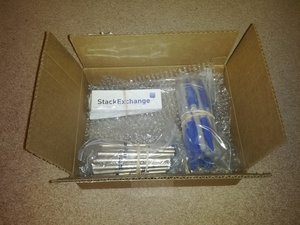Dark matter on the mind
Posted by David Zaslavsky on — Edited
There are a few interesting experimental results and analyses from the physics world this week, mostly having to do with dark matter. Probably the biggest of these is a fairly detailed paper on the local density of dark matter by the team of Moni Bidin, Carraro, Méndez, and Smith. As you may know, dark matter is astrophysicists’ favorite method to explain how the tangential velocity of stars in large galaxies can be nearly constant all the way from the center out to the (visible) edge, despite the fact that a simple model would tell you that the velocity should be slower for stars further out. It explains a bunch of other observations too, including measurements of gravitational lensing by large galaxy clusters, so we’re pretty confident that dark matter exists.
With that in mind, it’s kind of surprising that the analysis done by Moni Bidin, Carraro, Méndez, and Smith finds no dark matter at all within a few kiloparsecs of the solar system! Basically, what they’ve done is apply Newtonian gravity (which applies fairly well on these scales), along with ten reasonable-sounding assumptions, to find a formula which relates the velocities of stars in some region of …

